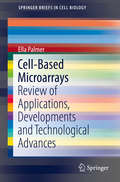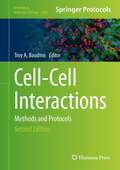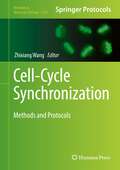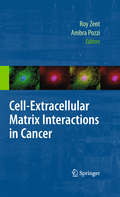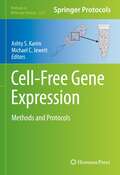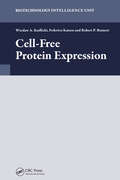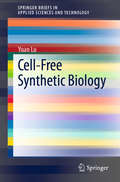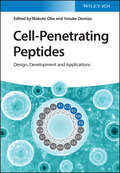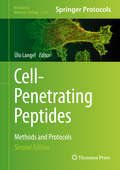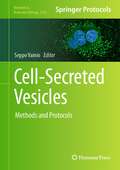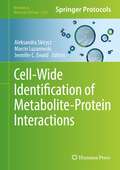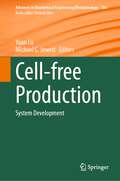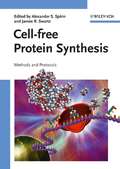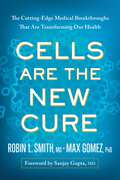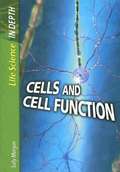- Table View
- List View
Cell-Based Microarrays: Review of Applications, Developments and Technological Advances (SpringerBriefs in Cell Biology #706)
by Ella PalmerAs a high throughput method for analyzing gene function, cell-based microarrays have proven to be of vital importance, allowing high throughput analysis of over expression and knock down of proteins. In Cell-Based Microarrays: Methods and Protocols, experts in the field provide an up to date synopsis of cell-based microarrays and meticulous coverage of all aspects of the array, including emerging technology. Beginning with a detailed overview of the whole subject area, the volume continues with protocols for over-expression arrays and downstream functional assays, infectious disease research, increasing transfection efficiencies, as well as the development of cell-based array technology by use of microfluidic image cytometry for the analysis of small diagnostic samples with few cells. Written in the highly successful Methods in Molecular BiologyTM series format, chapters include introductions to their respective topics, lists of the necessary materials and reagents, step-by-step, readily reproducible laboratory protocols, and notes on troubleshooting and avoiding known pitfalls. Comprehensive and cutting-edge, Cell-Based Microarrays: Methods and Protocols serves as a key resource for molecular biologists, geneticists, immunologists, and chemists, and supplies scientists with access to set up a technology that is truly high throughput for the functional analysis of proteins.
Cell-Based Therapies in Stroke
by Piotr Walczak Jukka JolkkonenStroke remains one of the main causes of death and disability worldwide. While effective therapy for stroke recovery remains an unmet need. Much hope and promises are placed on cell-based therapies. The aim of this book is to provide focused yet comprehensive reviews on the current state of cell-based approaches in the treatment of stroke. The topics covered include experimental data on functional outcome after intravascular and intracerebral delivery of cells in stroke animals, followed by translational chapters which will rely heavily on the use of different imaging modalities in the tracking of cells. The last and most challenging part will describe the early phase of clinical studies, providing guidelines for future research and clinical applications. Clearly and concisely written, this text will be a useful resource for neurologists, radiologists, and neuroscientists interested in cell transplantation as a therapeutic strategy for stroke patients.
Cell-Cell Interactions: Methods and Protocols (Methods in Molecular Biology #1066)
by Troy A. BaudinoIn the second edition of Cell-Cell Interactions: Methods and Protocols, expert researchers in the field detail a collection of protocols to examine interactions between cells. These include protocols that focus on both in vivo and in vitro methods-based approaches. New updated chapters also bring together many currently used assays in examining cell-cell interactions and the biological consequences of those interactions. Written in the highly successful Methods in Molecular Biology series format, chapters include introductions to their respective topics, lists of the necessary materials and reagents, step-by-step, readily reproducible laboratory protocols, and key tips on troubleshooting and avoiding known pitfalls. Authoritative and Practical, Cell-Cell Interactions: Methods and Protocol, Second Edition is a valuable resource for researchers who are already involved in the cell-cell interaction field, and also for those that are new to the area.
Cell-Cycle Synchronization: Methods and Protocols (Methods in Molecular Biology #2579)
by Zhixiang WangThis volume covers a broad range of cell types including cultured cell lines, primary cells, and various unicellular organisms such as fission yeast, budding yeast, parasite Leishmania amazonensis, and parasite Trypanosoma brucei. The chapters in this book are organized into four parts. Part One looks at a general overview of cell cycle control and synchronization. Part Two discusses techniques to synchronize mammalian cells to various cell cycle phases including mitotic sub-phases. Part Three covers synchronization of unicellular organisms and Part Four analyzes cell cycle progression. Written in the highly successful Methods in Molecular Biology series format, chapters include introductions to their respective topics, lists of the necessary materials and reagents, step-by-step, readily reproducible laboratory protocols, and tips on troubleshooting and avoiding known pitfalls. Cutting-edge and thorough, Cell-Cycle Synchronization: Methods and Protocols is a valuable resource for both novice and expert scientists in this developing field.
Cell-Extracellular Matrix Interactions in Cancer
by Roy Zent Ambra PozziCancer was thought to originate from alterations in intercellular signaling that resulted in the transformation of cells, their uncontrolled proliferation and metastasis. There is now an increasing body of evidence demonstrating that the surrounding matrix and cell-matrix interactions are also major players in this process. Cells adhere and receive signals from various extracellular matrices via transmembrane receptors, the best known of which are the heterodimeric glycoproteins, integrins.
Cell-Free Gene Expression: Methods and Protocols (Methods in Molecular Biology #2433)
by Ashty S. Karim Michael C. JewettThis detailed volume explores perspectives and methods using cell-free expression (CFE) to enable next-generation synthetic biology applications. The first section focuses on tools for CFE systems, including a primer on DNA handling and reproducibility, as well as methods for cell extract preparation from diverse organisms and enabling high-throughput cell-free experimentation. The second section provides an array of applications for CFE systems, such as metabolic engineering, membrane-based and encapsulated CFE, cell-free sensing and detection, and educational kits. Written for the highly successful Methods in Molecular Biology series, chapters include introductions to their respective topics, lists of the necessary materials and reagents, step-by-step, readily reproducible laboratory protocols, and tips on troubleshooting and avoiding known pitfalls. Authoritative and practical, Cell‐Free Gene Expression: Methods and Protocols serves as an ideal guide for researchers seeking technical methods to current aspects of CFE and related applications.
Cell-Free Protein Expression
by W. Antoni KudlickiFollowing its inception in the 1950s, cell-free protein synthesis made a tremendous impact on the basic life sciences. The use of cell-free systems was key to understanding molecular mechanisms underlying one of the most complicated processes found in nature: protein translation. Since this time, aggressive cutting-edge research and stiff commerica
Cell-Free Protein Production: Methods and Protocols (Methods in Molecular Biology #607)
by Takuya Ueda Yaeta Endo Kazuyuki TakaiDuring the past decade as the data on gene sequences and expression patterns rapidly accumulated, cell-free protein synthesis technology has also experienced a revolution, becoming a powerful tool for the preparation of proteins for their functional and structural analysis. In Cell-Free Protein Production: Methods and Protocols, experts in the field contribute detailed techniques, the uses of which expand deep into the studies of biochemistry, molecular biology, and biotechnology. Beginning briefly with basic methods and historical aspects, the book continues with thorough coverage of protein preparation methods, the preparation of proteins that are generally difficult to prepare in their functional forms, applications of the cell-free technologies to protein engineering, as well as some methods that are expected to constitute a part of future technologies. Written in the highly successful Methods in Molecular BiologyTM series format, the chapters include introductions to their respective topics, lists of the necessary materials and reagents, step-by-step, readily reproducible laboratory protocols, and notes on troubleshooting and avoiding known pitfalls. Authoritative and cutting-edge, Cell-Free Protein Production: Methods and Protocols aims to help researchers continue the growth of the vital exploration of cell-free sciences and technologies in order to better understand the dynamic lives of cells.
Cell-Free Protein Synthesis: Methods and Protocols (Methods in Molecular Biology #1118)
by Kirill Alexandrov Wayne A. JohnstonCell-free protein expression promises to narrow the technological gap between DNA and protein technologies and provide a platform for broad application of synthetic biology principles in the Life Sciences. It is a rapid and high throughput methodology for the conversion of DNA encoded genetic information into protein-mediated biochemical activities. "Cell-Free Protein Synthesis: Methods and Protocols "brings together the key opinion leaders of cell-free technology development and provides case studies and detailed protocols for the application of cell-free methodology. Chapters cover the main directions in the development of cell-free technologies including several recently developed cell-free systems, as well as a number of applications of cell-free systems ranging from discovery of biofuel enzymes to "in vitro" assembly of viruses. Written in the successful "Methods in Molecular Biology" series format, chapters include introductions to their respective topics, lists of the necessary materials and reagents, step-by-step, readily reproducible protocols, and notes on troubleshooting and avoiding known pitfalls. Authoritative and easily accessible, "Cell-Free Protein Synthesis: Methods and Protocols "seeks to serve a wide variety of scientists with its well-honed methodologies.
Cell-Free Synthetic Biology (SpringerBriefs in Applied Sciences and Technology)
by Yuan LuThis book describes advanced studies in cell-free synthetic biology, an emerging biotechnology that focuses on cell-free protein synthesis and cell-free systems for fundamental and industrial research in areas such as genetic circuit design, small-molecule synthesis, complicated-macromolecule synthesis, unnatural-macromolecule synthesis, high-throughput screening, artificial cells, and biomaterials. Cell-free synthetic biology is now an integral part of developing fields like nanotechnology, materials science, and personalized medicine. The book discusses the main research directions in the development of cell-free systems, as well as a number of applications of cell-free synthetic biology, ranging from structural biology to the human health industry. It is intended for students and researchers in life sciences, synthetic biology, bioengineering, and chemical engineering.
Cell-Inspired Materials and Engineering (Fundamental Biomedical Technologies)
by Daniel Packwood Dan Ohtan WangThis book highlights cutting-edge studies in the development of cell-inspired biomaterials and synthetic materials that manipulate cell functions and provide the next generation with contemporary tools for treating complex human diseases. It explores the convergence of synthetic materials with cell and molecular biology and surveys how functional materials, when patterned with spatial and temporal precision, can be used effectively to maintain cell proliferation and phenotype in vitro, to trigger specific cell functions, and to redirect cell-fate decisions. Human stem cells are a frequently discussed subject in this book. This is an ideal book for students, cell biologists, researchers interested in interdisciplinary research, and biomedical engineers. This book also: Highlights successfully developed technologies in cell engineering that make possible new therapeutic development for previously untreatable conditions Covers topics including bio-inspired micro patterning, DNA origami technology, synthetic NOS inspired by compartmentalized signaling in cells, and light-induced depolarization of the cell membrane Illustrates in detail the use of stem cells and synthetic scaffolds to model ethically sensitive embryonic tissues and organs
Cell-Penetrating Peptides: Design, Development and Applications
by Makoto Oba Yosuke DemizuCell-Penetrating Peptides The definitive reference on the rational design of cell-penetrating peptides enables readers to develop tailor-made peptides for their specific needs. In recent years, cell-penetrating peptides (CPPs) have become valuable tools for the cellular delivery of proteins, nucleic acids, and drugs. These small peptide sequences can be artificially designed and synthesized with custom-made characteristics to mediate the efficient and non-toxic transport of biomolecules, drugs, or nanoparticles into the cell. Cell-Penetrating Peptides: Design, Development, and Applications provides an up-to-date account of the development and use of CPPs for delivering membrane-impermeable bioactive molecules into cells. Bringing together contributions from leading researchers from around the world, this comprehensive volume describes the characteristics and mechanisms of CPPs as well as their application in both medicine, biotechnology and agriculture. Covers rational design and development of cell-penetrating peptides for use in cellular delivery of small molecule drugs, proteins, nucleic acids, and nanoparticles Presents the chemical and biological characteristics of CPP action in vitro and in vivo Describes the structure and design principles of both synthetic and naturally occurring CPPs Discusses key medical applications of CPPs such as oral delivery, intranasal delivery, and clinical trials Cell-Penetrating Peptides: Design, Development, and Applications is an essential resource for biochemists, medicinal chemists, molecular biologists, biotechnologists, and researchers studying CPPs in both academia and industry.
Cell-Penetrating Peptides: Methods and Protocols (Methods in Molecular Biology #1324)
by Ülo LangelIn recent years, a new understanding of cell-penetrating peptides has emerged, helping researchers to expand beyond a number of long-held dogmas. In Cell-Penetrating Peptides: Methods and Protocols, expert researchers explore the latest information on cell-penetrating peptides (CPPs), providing insight into the most important and contemporary areas of CPP research. Chapters address the historical background of CPP studies, provide an overview of the growing field of research, investigate methods for testing CPP mechanisms, present a summary of methods that attempt to use properties of CPPs to study biochemical intracellular mechanisms of interaction and signal transduction, and include new ideas for turning CPP-based strategies into drugs. Composed in the highly successful Methods in Molecular BiologyTM series format, each chapter contains a brief introduction, step-by-step methods, a list of necessary materials, and a Notes section which shares tips on troubleshooting and avoiding known pitfalls. Innovative and current, Cell-Penetrating Peptides: Methods and Protocols is an essential guide that allows researchers to study intracellular mechanisms in new ways, and to promote the future development of novel drugs.
Cell-Secreted Vesicles: Methods and Protocols (Methods in Molecular Biology #2668)
by Seppo VainioThis detailed volume presents hands-on technological protocols used to target an array of cell-secreted extracellular vesicles (EVs) in a variety of biological systems. Beginning with methods for EV purification and analysis, the book continues with sections on the study of EV functions as well as specific systems and models allowing for the study of EVs of different origin. Written for the highly successful Methods in Molecular Biology series, chapters include introductions to their respective topics, lists of the necessary materials and reagents, step-by-step and readily reproducible laboratory protocols, and tips on troubleshooting and avoiding known pitfalls. Authoritative and practical, Cell-Secreted Vesicles: Methods and Protocols serves as an ideal guide to conducting systematic assays in an effort to further our understanding of the mode of assembly, secretion, and targeting of EVs which will serve eventually as new therapeutic openings.
Cell-Wide Identification of Metabolite-Protein Interactions (Methods in Molecular Biology #2554)
by Aleksandra Skirycz Marcin Luzarowski Jennifer C. EwaldThis thorough volume explores protocols of proteome- and metabolome-wide strategies for the identification of protein-small molecule complexes in different organisms, in order to shed light on these important regulatory interactions. Experimental and computational strategies to characterize protein-metabolite interactions are discussed, and recent advances in enabling technologies are featured as well. Written for the highly successful Methods in Molecular Biology series, chapters include the kind of detail and expert implementation advice to ensure success in future research. Authoritative and practical, Cell-Wide Identification of Metabolite-Protein Interactions will aid researchers seeking a better understanding of the mechanisms of signal transduction occurring in the cell and assessing the effect of complex formation on cell physiology.
Cell-based Immunotherapies for Cancer
by Alok K. Mishra Sunil K. MaloniaThis book explores the rapidly evolving field of cancer immunotherapy, which focuses on harnessing the immune system's power to combat cancer. As traditional treatments like chemotherapy and radiation therapy often have significant side effects and may not be effective for all cancer types, immunotherapy offers a promising alternative. Among the most notable advancements in this field are cell-based therapies, which involve modifying a patient&’s own immune cells or engineering specialized cells to enhance their ability to target cancer. Key approaches include chimeric antigen receptor (CAR) T-cell therapy, tumor-infiltrating lymphocyte (TIL) therapy, and dendritic cell (DC)-based therapy. Providing a comprehensive overview of these therapies, this book explores their scientific foundations, recent developments, clinical applications, and associated challenges. It also discusses emerging immunotherapeutic strategies, the commercial landscape, and future research directions. A valuable resource for researchers, clinicians, and industry professionals involved in cancer treatment, this book also serves as an informative reference for students and academics in biology, biotechnology, immunology, and related disciplines seeking a deeper understanding of cancer immunotherapy.
Cell-free Macromolecular Synthesis (Advances in Biochemical Engineering/Biotechnology #185)
by Yuan Lu Michael C. JewettThis book reviews cell-free production systems, exploring the frontiers in cellular engineering and biotechnology. With contributions from experts in the field, the book offers a comprehensive and up-to-date account of the latest advancements and practical applications. The volume covers a diverse range of topics, beginning with an in-depth analysis of cell-free display techniques for protein evolution, shedding light on the methodologies used to engineer proteins for diverse purposes, followed by an examination of bottom-up synthetic biology employing cell-free protein synthesis. Additionally, it investigates the intricacies of the cell-free synthesis of metalloproteins, elucidating the unique properties and functionalities of these biologically important molecules.In this book, particular attention is given to the integration of cell-free production systems with droplet microfluidics, a pioneering approach that has revolutionized research activities in both academic and industrial settings. Readers will also discover the latest advancements in cell-free protein synthesis and immobilization, and find out more about the eCell technology, which combines cell-free protein synthesis with bio-sensing and remediation, revolutionizing critical areas of study in biotechnology. Together with the companion volume entitled “Cell-free Production: System Development”, both books highlight the research progresses on the basic and applied research of cell-free production systems in the last few years, and are invaluable resources for scholars, researchers, and bioengineers. This book also appeals to enthusiasts of synthetic biology.
Cell-free Production: System Development (Advances in Biochemical Engineering/Biotechnology #186)
by Yuan Lu Michael C. JewettThis book reviews the development of cell-free production platforms and offers an authoritative perspective of the latest advances and methodologies in cell-free production systems. Readers will discover the biomanufacturing potential of in vitro biotransformation (ivBT) employing purified cascade multi-enzymes, the development of hydrogel-based multi-enzymatic systems for biosynthesis, and novel insights into the optimization of biocatalytic processes. Additionally, the book explores the cell-free production and regeneration of cofactors, shedding light on strategies to enhance the efficiency and sustainability of cellular processes. In this book, particular attention is given to the progress of cell-free in vitro evolution techniques for optimizing enzyme performance, and the book also presents the integration of rapid and finely-tuned expression systems for deployable sensing applications, revolutionizing the field of biosensing. The synthesis and electrophysiological analysis of multipass voltage-gated ion channels tethered in microsomal membranes are explored, providing a deep understanding of cellular function at the molecular level. Lastly, the book covers compartmentalized cell-free expression systems for building synthetic cells, showcasing the potential for constructing artificial cellular systems with unique functionalities. Given its breadth, this book appeals to academics, researchers, and professionals interested in the forefront of biotechnology, and together with the companion volume “Cell-free Macromolecular Synthesis”, both books highlight the research progresses on the basic and applied research of cell-free production systems in the last few years, being invaluable resources in the field.Chapter “Cell-free synthesis and electrophysiological analysis of multipass voltage-gated ion channels tethered in microsomal membranes” is available open access under a Creative Commons Attribution 4.0 International License via link.springer.com.
Cell-free Protein Synthesis: Methods and Protocols
by Alexander S. Spirin James R. SwartzWith its detailed description of membrane protein expression, high-throughput and genomic-scale expression studies, both on the analytical and the preparative scale, this book covers the latest advances in the field. The step-by-step protocols and practical examples given for each method constitute practical advice for beginners and experts alike.
Cells
by Kathy FrenchFind out about the discovery of cells, the parts of cells, the function of cells and differentiate between plant and animal cells.
Cells Are the New Cure: The Cutting-Edge Medical Breakthroughs That Are Transforming Our Health
by Robin L. SmithThe future of medicine is happening now. Revolutionary new science is providing cures that were considered science fiction just a few years ago—and not with pills, surgery, or radiation, but with human cells. Promising treatments now in extensive clinical trials could have dramatic impacts on cancer, autoimmune diseases, organ replacement, heart disease, and even aging itself. The key to these breakthroughs is the use of living cells as medicine instead of traditional drugs. Discover the advances that are alleviating the effects of strokes, Alzheimer's disease, and even allergies. Cells Are the New Cure takes you into the world of regenerative medicine, which enables doctors to repair injured and aging tissues and even create artificial body parts and organs in the lab. Cellular medicine experts Robin L. Smith, MD, and Max Gomez, PhD, outline the new technologies that make it possible to harness the immune system to fight cancer and reverse autoimmune diseases like multiple sclerosis, type 1 diabetes, and rheumatoid arthritis. CRISPR, a new technology for targeted gene editing, promises to eradicate genetic diseases, allowing us to live longer lives—possibly even beyond age 100 in good health. Cells Are the New Cure takes you on a tour of the most exciting and cutting-edge developments in medicine. The content inside these pages could save your life or the life of someone you love.
Cells and Cell Function (Life Science in Depth)
by Sally MorganThese titles provide an in-depth look at life processes. The books stress key features of science teaching including scientific inquiry, use of ideas and evidence in science, planning, evaluation, and developing investigative skills. Sample experiments and data illustrate best practices in a real context. Case studies of key experiments and discoveries in the history of science are presented as box features (including modern discoveries as well as those with historical importance). Information on the most recent developments in research demonstrates the progressive nature of science.
